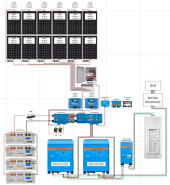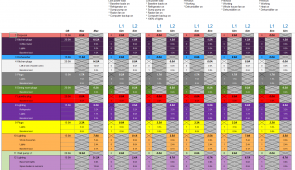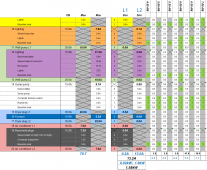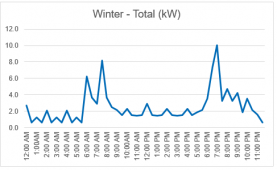Hi all,
Some solar design for open criticism. It's been really informative reading the many post here. Thanks for the information. My design seems a little too simple for nothing to be wrong.
Thank you, Steve





Some solar design for open criticism. It's been really informative reading the many post here. Thanks for the information. My design seems a little too simple for nothing to be wrong.
Thank you, Steve
- Plan to upgrade from a 150A main panel to a 200A panel first, to be able to accommodate an EV charger at some point in the future. Also, more spaces in the panel as we may add on next year (Upgrading to a smart panel too, so I can monitor and control at a CB level)
- 6x2 solar combiner with 15A per string protection / Solar cutoffs in the PV combiner box / South facing solar
- Solar controllers would be 2x Victron MPPT 150/70 TR-VE.Can
- Victron 48VDC/12VDC for the Cerbo GX and other 12VDC needs
- Lynx distribution and Cerbo GX for system management
- I want to prioritize solar/battery, but Grid is backup / No desire to export to grid (i.e. zero-export)
- Battery bank to accommodate dips in generation throughout the day and for backup (I can turn things off in the event of an extended outage to extend)
- 2 Victron Quattro 48V/5kW/120VAC inverters in split phase (looking for the 100A pass through that these are rated for to go with a 200A panel)
- 100A Victron autotransformer (balancing the legs) / Due to the loads on my panel, I can have up to a 25A differential between the legs
- No critical loads panel, I want to push everything through one panel
- Would add a 200A breaker between the grid and the inverter inputs (Not shown, but where the service disconnect would be)
- Expandability options: More batteries, more solar if needed (thus the extra feed ins on the Lynx Power in)
- Communication cables not shown
- Also, my electrical consumption model of the house is below.
- Would I need a transfer switch for cutoff in the event of grid disruption (anti-islanding)? Not positive if the Quattros do this or if I need a separate device.
- Does the Quattro actually blend grid and solar / battery power? / In other words, does it just use the solar/battery until below a certain SOC and then switch over the whole source to grid by going into bypass mode? I have not been able to get a good idea of this, based on what I've read. Not sure how much of a difference this makes, but is seems like blending would reduce the number of cycles on the batteries.
- Additional fusing / breakers? I might bump the 100A fuses in the Lynx Distributor to 125A and bump the breakers on the MPPT outputs to 80A.







